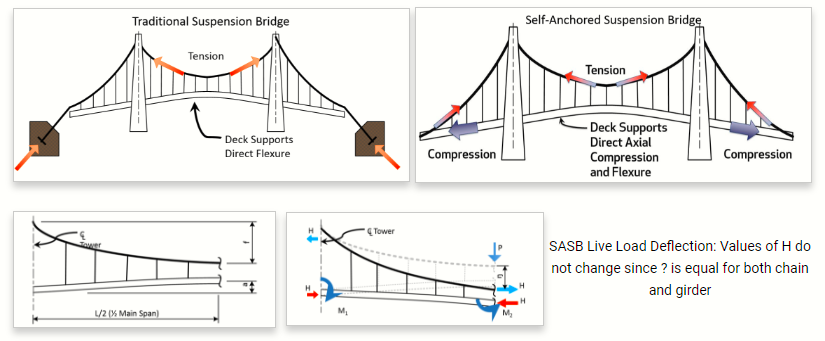Self-Anchored Suspension Bridge - Andy Warhol Bridge (PA)

Author: Aaron Colorito
Publish Date: 11 Nov, 2018
Synopsis of the Presentation

Project Information
- Located in Pittsburgh, PA over Allegheny River
- Second bridge at this site
- Replaced 1884 Gustav Lindenthal suspension bridge
- Mandated by 1889 River and Harbor Act
- First self-anchored suspension bridge in U.S.
- Constructed by American Bridge Co. and Foundation Co. of NY
- First of the “Three Sisters” constructed from 1924-1928

Key Technical Issue 1: Self-Anchored Suspension Bridge (SASB) Mechanics
- Need for end anchorages eliminated
- Reduces right-of-way required
- Girder sized for compression & flexure
- Analysis by the elastic theory as an independent check
- Deflection theory of suspension bridges also applicable, may be reduced to elastic theory
- Special considerations for live load analysis
Overview of the Traditional vs. Self-Anchored Suspension Bridges

Key Technical Issue 2: Create Finite Element Model for SASB for various purposes
A series of models are created for different purposes:
- Geometry
- Initial Force System
- Loading & Boundary Conditions
- New Dead Loads
- Moving & Static Live Loads
- Construction Staging (Deck Removal & Pouring Sequences)
- Pedestrians-Only Load Case

FEA Modeling Process
1. The initial model is created using the Suspension Bridge Wizard of midas Civil. However, the Suspension Bridge Wizard creates the normal (externally-anchored) suspension bridge model. Therefore, further modifications were made to convert the model to be self-anchored.

2. Manual modifications are made in order to reflect the self-anchorage system. The Post-Wizard Modifications are:
- Replace end boundary conditions
- Insert floor system (floorbeams and stringers)
- Insert rigid links at girder/chain ends
- Modify Suspension Bridge Analysis Control

3. Additional Studies and FEA modeling are done for the study of the following issues:
- Moving & Static Live Loads
- Construction Staging (Deck Removal & Pouring Sequences)
- Pedestrians-Only Load Case

Key Technical Issue 3: Results & Verification (Expectations vs. Reality)
The expectations such as below:
- Elastic Theory will give larger dead load forces
- Stiffening girder end moments same sign
- Stiffening girder DL moments same order of magnitude
For the reality, the plan sheet forces, the elastic theory and MIDAS results are compared:


Do you want to learn how to use? Click Here
| |
Speaker : Aaron Colorito, PE, CBSI Category : Bridge Software : midas Civil Date : 2016-08-03 |





Add a Comment